


The medieval church season of Lent officially opened with Ash Wednesday, the Wednesday after Quinquagesima Sunday (the period of fifty days before Easter). The observance of Ash Wednesday marked forty fast days before Easter, not counting Sundays. During Lent, medieval Christians were forbidden to consume meat, eggs, dairy and animal fats, except on the permitted Sundays which were viewed as a “mini-Easter.” By adding a level of restraint to their daily lives, medieval Christians fulfilled a call for penance, which was especially important during the Lenten season. On Ash Wednesday, in the Middle Ages as it is now, a celebration of Mass incorporated the distribution of blessed ashes on the foreheads of believers. When dispensing the ashes, the celebrant reminds those receiving it that “as you are from dust, from dust you shall return” (based on Genesis 3:19).

The Index records three examples in manuscript illumination of the distribution of ashes. Each begins a part of a liturgical book read for this feast: a Gradual fragment in Princeton University Library (Kane 13), a Gradual in the Morgan Library (M.933), and a Missal in the Walters Art Museum (W.174). The Morgan and Princeton Graduals begin with the same Latin Introit, “Misereris omnium domine et nichil odisti eorum…” (Thou hast mercy upon all, O Lord, and hatest nothing…). It is interesting to note that the subject heading “Scene, Liturgical: Distribution of Ashes” used by the Index now was not in the original card file but was developed sometime during the last twenty years when post-1400 material was incorporated into the Index.


Episodes from the life of Saint Blaise: Saint Blaise living with animals; extracting the fishbone; restoring the pig, and martyred with steel combs. Vitae Sanctorum, Anjou, 14th c. (Bib. Vat., MS lat. 8541), fol. 52v.
February 3 in the Roman Catholic calendar and February 11 in the Orthodox one mark the feast day of Saint Blaise, Bishop of Sebaste in Armenia in the early fourth century. According to his hagiography, Blaise had been trained as a physician before becoming a bishop in the early Christian church, an institution still outlawed in the Roman Empire. Seeking solitary prayer in the wilderness, he lived peacefully with the wild animals until his arrest by Roman soldiers on the orders of the Roman governor Agricola, under whom he was imprisoned, tortured, and martyred. Blaise’s best known miracles include his restoration of a pig to a woman from whom it was stolen by a wolf who returned it on the saint’s command, and the cure of a boy who was choking on a fishbone. This second miracle resulted in Blaise’s designation as the patron saint of those suffering from throat ailments, inspiring the annual tradition of the Blessing of the Throats on Saint Blaise’s Day, also known in the west as Candlemas.
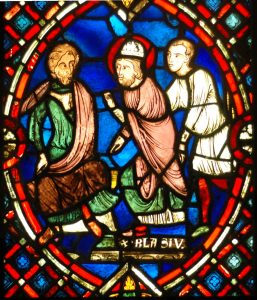
Saint Blaise before Agricola, detail of a stained glass window from the Soissons region, first quarter of the 13th c (Louvre, OAR 504).
In the Index of Christian Art, Blaise is catalogued as “Blasius of Sebaste.” He is typically depicted wearing his bishop’s robe and miter and holding a crozier. In later medieval art, he often holds a wool carder’s comb, perhaps a medieval reinterpretation of the Roman steel combs with which his flesh is said to have been raked during his martyrdom. Post-medieval images sometimes depict him holding two crossed candles in an allusion to the Blessing of the Throats. His most common narrative depictions show him meditating or ministering among the wild beasts; extracting the fishbone from the choking boy; standing before Agricola; or in the act of martyrdom, sometimes accompanied by the seven pious women who, according to Eastern tradition, followed him throughout his torments, wiping up his blood.
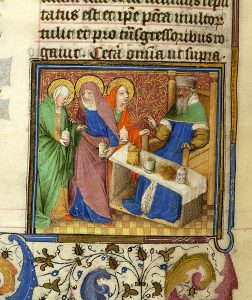
The marketplaces of medieval Europe were redolent of the spices that purportedly first arrived with returning Crusaders. A taste for the flavors of cinnamon, clove, nutmeg, ginger, pepper and the like created an increasing demand for spices that could not be grown in Europe’s climate but had to be imported from the East along secret trade routes, over land and sea. Distance was only one of several factors that affected the supply of spices, which were expensive and enjoyed only by those who could afford them. Nevertheless, as Paul Freedman writes in his blog “Spices: How the Search for Flavors Influenced our World,” the new taste for exotic flavors helped encourage world exploration and turn spices into global commodities.
The uses of spices were both culinary and medical, and medieval cookbooks and herbals reveal that spices were part of preferred regimens. Spices were taken together in varying combinations, sometimes seasonal. In the cold and wet winter months, it was advisable to eat spices in strongly flavored food and drink to warm the body. Maguelonne Toussaint-Samat notes in her History of Food that the physician Arnau de Villanova (c. 1240-1311) recommended balancing the four humors of the body by consuming spices “proper for winter” as zesty sauces of ginger, clove, cinnamon, and pepper (Toussaint-Samat, 486). These spices would aid digestion after a heavy winter meal by heightening the effects of “hot” and “humid” properties in roasted meats. To this day, the warming spices advocated by Arnau de Villanova tend to be associated with fall and winter.
Cameline sauce, perhaps the original steak sauce, was the perfect accompaniment to roast meats. Prepared in summer and winter months alike, the sauce was so popular in some locations, such as fourteenth-century Paris, that the blend was usually readily available from the local sauce maker. There were regional varieties of Cameline sauce, too, and the “Tournais style” involved grinding together ginger, cinnamon, saffron and half a nutmeg. The spice powder was soaked in wine and stirred together with bread crumbs. The strained mixture was then boiled, with sugar added to make the winter variety of the sauce. One recipe for Cameline sauce has been adapted by Daniel Myers for the Medieval Cookery web site and is reproduced here with permission.
Cameline Sauce
3 slices white bread
3/4 cup red wine
1/4 cup red wine vinegar
1/4 tsp. cinnamon
1/4 tsp. ginger
1/8 tsp. cloves
1 tbsp. sugar
pinch saffron
1/4 tsp. saltCut bread in pieces and place in a bowl with wine and vinegar. Allow to soak, stirring occasionally, until bread turns to mush. Strain through a fine sieve into a saucepan, pressing well to get as much the liquid as possible out of the bread. Add spices and bring to a low boil, simmering until thick. Serve warm.
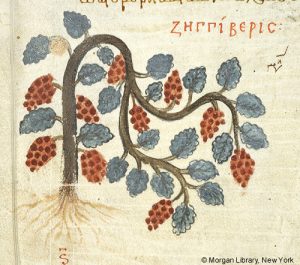
Ginger came to be highly prized during the Middle Ages, though the use of ginger can be traced back thousands of years in India and China. The potent ginger plant and rhizomes were valued for their stomach-warming and digestive properties as much as for the flavors they imparted. The first-century Greek physician Dioscorides advocated consuming a spicy Arabian plant called ζιγγίβερις (zingiberis), which was probably ginger, to “soften the intestines gently.” In Arabia, Dioscorides noted, they used only the freshest ginger plants (O’Connell 116-117).
Clove was known as one of the “lesser spices.” Though not as strong as ginger but useful for its antiseptic and anti-inflammatory properties, clove was especially useful in dental care.
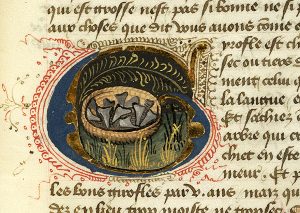
Named in English and other languages—“clou de girofle” in French—for the resemblance of the bud to nails, clove originated in the Moluccan Islands of Indonesia, the historical core of the Spice Islands. As with ginger, clove had its earliest uses in India and China in the fourth-century BCE, finding its way to Roman and Greek markets by way of port cities on the Mediterranean. By the eighth century, clove was known throughout Europe and features in several historic dishes. It was also a typical spice in pomanders, the medieval precursor to potpourri, in which fragrant ingredients were placed in a perforated box to ward off illness. The decorative use of clove-studded oranges, a seasonal pomander, is still associated with the winter months.

Hippocras, or hypocras, was a medieval spiced wine and popular cordial enjoyed especially during the winter holidays for several centuries. Hippocras was a concoction of powdered cinnamon, cassia buds, ginger, grains of paradise and nutmeg boiled with sugar and wine. Cinnamon, the essential flavor of hippocras, was a favorite spice of the medieval palate. Its mysterious origins generated many fanciful tales and even several expeditions. Perhaps most famously, the Genoese explorer Christopher Columbus thought he had located the spice in America—the Indies to him— and in 1493 he reportedly brought back bits of bark from a perfumed wild cinnamon tree that was not very tasty.
Long before Columbus, the ancient Egyptians had prized cinnamon as the “… goodly fragrant woods of The Divine Land…” while medieval Arabs believed that large birds used cinnamon sticks in their nests (O’Connell, 76-77). In the first century, the Roman natural philosopher Pliny the Elder rightly located the origin of cinnamon on the shores of the Indian Ocean. With information from some seasoned merchant, perhaps, Pliny knew that the cinnamon trade was dangerous and that a return trip to the source of the spice took almost five years. Pliny’s claims about the origin of cinnamon were eventually verified in the 1340s when the Moroccan explorer Ibn Battuta (1304–c. 1368) arrived at the island of Sri Lanka (formerly Ceylon) and discovered untouched miles of the cinnamon tree. Before its widespread appreciation as a culinary ingredient, cinnamon was prized in several ancient cultures as incense holding ritualistic importance, sometimes burned for its fragrance on a funeral pyre.
The final “proper” winter spice is pepper. With a name widely applied to many spices, including the black and white varieties, pepper was perhaps the most familiar spice of the Middle Ages. Both black pepper and white pepper are obtained from the small berries of the Piper nigrum vine.
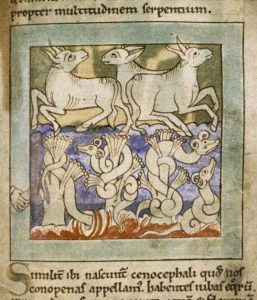
Unripe berries are green, and ripe berries are red. Dried ripe berries yield white pepper, and despite the fantastic medieval legend propagated by Isidore of Seville (560–636) that the scorching of pepper crops blackened the berries and drove out the poisonous guard snakes, unripe pepper berries are simply plucked, gathered, cooked, and then dried to give us the most familiar variety, black pepper. The principal traders of pepper came from India where the vines thrived in tropical regions. Pepper was used in medicine to aid digestion and to treat ailments like gout and arthritis, as well as infectious diseases like the bubonic plague.
The term “peppercorn rent” derives from the practice established in early common law in England that payment of rent or tax might be made by a peppercorn, to avoid the bother of exchanging real currency. Usually no peppercorns were actually collected during these transactions, but the spice represented a hard asset, and the term is still in use today in legal parlance to describe a token amount of rent money paid in order to keep a title alive. In all seasons, spices and their increasingly globalized trade during the Middle Ages affected medieval economies, and brought social, culinary, and health benefits to Europe. To this day, the flavors and aromas of medieval markets spice up the long, cold winter months.
Sources
Paul Freedman, “Spices: How the Search for Flavors Influenced Our World,” The YaleGlobal Online Blog, March 11, 2003, http://yaleglobal.yale.edu/content/spices-how-search-flavors-influenced-our-world.
Daniel Myers. “Cameline Sauce.” Medieval Cookery. Last modified July 13, 2006. http://medievalcookery.com/recipes/cameline.html.
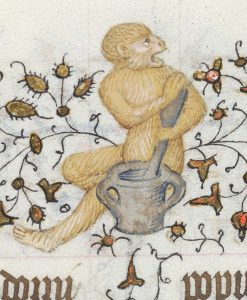
Freedman, Paul. Out of the East: Spices and Medieval Imagination. New Haven: Yale University Press, 2008.
Toussaint-Samat, Maguelonne. A History of Food. Translated by Anthea Bell. Oxford: Wiley-Blackwell, 2009.
Leah Hyslop, “Where do Christmas spices come from?” The Telegraph.co.uk (blog), December 22, 2015, http://www.telegraph.co.uk/gardening/grow-to-eat/where-do-christmas-spices-come-from/
O’Connell, John. The Book of Spice: From Anise to Zedoary. London: Profile Books, 2015.
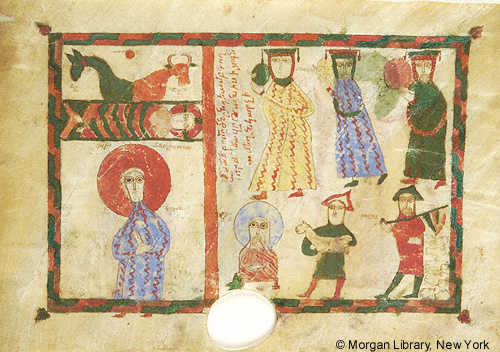
As friends and colleagues around the world prepare to celebrate festivals of light, we at the Index wish you all a luminous holiday season and a peaceful, prosperous New Year.

The governing offices of medieval church and state – such as emperor, king, pope, archbishop, abbot, mayor, and so on – were often filled by election, in accordance with public and canon law. Often, election by a voting body facilitated the peaceful transference of power, even if such decisions also considered the privileges of birth and rank, as well as the requirements of the church.
Under canon law, medieval people were guaranteed certain human rights, including welfare rights, the right of certain classes to vote, and religious liberty (Helmholz 3). Canonists supported the free exercise of these rights, as they believed them to be supported by biblical tradition. Common law, or ius commune, upheld that a right order of government on earth was based in natural law and the upholding of these God-given rights. In effect, common law and canon law were seen as linked systems, to be enforced at the highest level to promote God’s plan for the world. Voting rights were recognized under both systems, so that secular elections evolved from the system put in place by medieval canonists for choosing offices within the church (Helmholz 6).
Medieval elections took place primarily in three contexts, ecclesiastical, secular and academic, but detailed evidence about them is scarce. Voting in both ecclesiastical and secular elections could follow one of four main procedures: overseen by an external authority with no direct interest in the election; by indirect election, in which electors named a proxy to select the officials; by lot; and by ballot (Uckelman and Uckelman 3). In contrast to most modern practice, electors had a limited choice, and the outcome of an election was always subject to the judgment of their superiors. Medieval law also ruled that all of the electors had to meet at the same time in the same place, whether or not the actual voting was done in secret. This was to mimic the meeting of the apostles at Pentecost and to wait for divine guidance before voting (Helmholz 8).
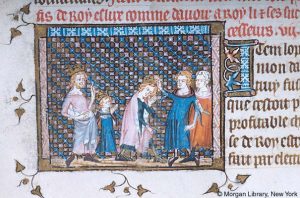
For some medieval rulers, the election, crowning, and anointing of Old Testament kings proved to be an excellent model for legitimizing their rule. Biblical tradition not only provided a justification for absolute reign, it also ensured that the church remained authoritative over secular rulers. In principle, the selection of a medieval monarch was based on both elective and hereditary elements, but from the tenth century in northern and central Europe, political and social trends steered toward hereditary succession over an elective monarchy (Nelson 183). This trend is exemplified in a French manuscript titled the Avis aus Roys, or royal advice book, dating to the mid-fourteenth century and possibly made for Louis, Duc d’Anjou (1339-1385). This book highlights the benefits of adhering to hereditary royal succession, which was widely seen as a more secure and manageable transference of power than other means of selecting a ruler.
The Church’s rules for filling ecclesiastical offices presented a paradox, as they strongly favored a mix of election and hierarchy. Before the papal bull In nomine Domini of 1059, which included an election decree, the pope’s successor was most often named by the incumbent pope or by secular rulers (Larson 151). Reforms put in place over the course of the twelfth and thirteenth centuries resulted in the creation of the first papal conclave (1276) and College of Cardinals, the familiar process for electing the pope that is still in practice today. Below the pope were elected cardinals, archbishops, bishops, and other local offices for priests and deacons. Episodes of their ritual consecration, ordination, vesting, installation, and taking orders feature prominently in the Index subject headings. Another elective office common in the Middle Ages was that of abbot or abbess of a monastery.
Among the more numerous depictions of Benedict of Montecassino delivering rule to monks is a rare episode in an Italian manuscript depicting him chosen as abbot. In this Vita Benedicti, dating to the mid-fifteenth century, a miniature depicts a group of monks presenting a letter, stamped with a dangling wax seal, to the new abbot-elect standing in the doorway of his mountain monastery.
The Index collection includes many images of election-related imagery, including depictions of medieval leadership, kingly coronations, ecclesiastical consecrations, synods, and deliberating monks. Typical subject headings include David: proclaimed King, Solomon: crowned King; Simon Thassi: chosen Leader of Machabees; Edmund of England: Scene, Coronation and Consecration; Guillaume de Machaut, Livre du Voir Dit: Scene, King addressing Court; and Louis of Toulouse: Scene, taking of Orders.
Sources
Benson, Robert L. The Bishop-Elect: A Study in Medieval Ecclesiastical Office. Princeton: Princeton University Press, 1968.
Barzel, Yoram, and Edgar Kiser. “The development and decline of medieval voting institutions: A comparison of England and France.” Economic Inquiry 35, no. 2 (1997): 244-60.
Uckelman, Sara L., and Joel Uckelman. “Strategy and manipulation in medieval elections.” Accessed in http://ccc.cs uni-duesseldorf. de/COMSOC2010/papers/logiccc-uckelman. pdf (2010), 1-12.
Helmholz, Richard H. “Fundamental Human Rights in Medieval Law.” (Fulton Lectures 2001): 1-18.
Nelson, Janet L. “Medieval Queenship.” In Women in Medieval Western European Culture, edited by Linda E. Mitchell, 179-208. New York and London: Routledge, 2011.
Weiler, Björn. “8 things you (probably) didn’t know about medieval elections.” History Extra Blog. N.p., 6 May 2015.
Larson, Atria. “Popes and Canon Law.” In A Companion to the Medieval Papacy: Growth of an Ideology and Institution, edited by Atria Larson and Keith Sisson, 135-37. Leiden: Brill, 2016.
 Our website has had a lot of new traffic since its launch, and some users have reported difficulties getting into the database from our homepage. Please remember that if you normally access the database through an institutional subscription, you may still need to enter through your library website, using your institutional credentials. If you encounter other kinds of access problems, please use the staff contacts to let us know. We are happy to help.
Our website has had a lot of new traffic since its launch, and some users have reported difficulties getting into the database from our homepage. Please remember that if you normally access the database through an institutional subscription, you may still need to enter through your library website, using your institutional credentials. If you encounter other kinds of access problems, please use the staff contacts to let us know. We are happy to help.
 The Index of Christian Art is pleased to invite applications for a one-year postdoctoral fellowship for AY 2017-2018, with the possibility of renewal contingent on satisfactory performance.
The Index of Christian Art is pleased to invite applications for a one-year postdoctoral fellowship for AY 2017-2018, with the possibility of renewal contingent on satisfactory performance.
Funded by a generous grant from the Kress Foundation, the Kress Postdoctoral Fellow will collaborate with permanent research and professional staff to develop taxonomic and research enhancements for the Index’s redesigned online application, which is set to launch in fall 2017. Salary is $60,000 plus benefits for a 12-month appointment, with a $2,500 allowance provided for scholarly travel and research. The Fellow will enjoy research privileges at Princeton Libraries as well as opportunities to participate in the scholarly life of the Index and the Department of Art & Archaeology.
The successful candidate will have a specialization in medieval art from any area or period; broad familiarity with medieval images and texts; a sound grasp of current trends in medieval studies scholarship; and a committed interest in the potential of digital resources to enrich work in art history and related fields. Strong foreign language and visual skills, the ability to work both independently and collaboratively after initial training, and a willingness to learn new technologies are highly desirable; previous experience in digital humanities, teaching, and/or library work is advantageous. Applicants must have completed all requirements for the PhD, including dissertation defense, before the start of the fellowship. Preference will be given to those whose subject expertise complements that of current Index staff.
Applications will be reviewed beginning January 15 and will continue until the position is filled. Applicants must apply on line at https://jobs.princeton.edu/applicants/jsp/shared/Welcome_css.jsp, submitting a C.V., a cover letter, a research statement, and the names and contact information of three references. The position is subject to the University’s background check policy.
Princeton University is an Equal Opportunity/Affirmative Action Employer, and all qualified applicants will receive consideration for employment without regard to age, race, color, religion, sex, sexual orientation, gender identity or expression, national origin, disability status, protected veteran status, or any other characteristic protected by law.
The Index is pleased to announce the speakers for two honorary sessions at the International Congress on Medieval Studies to be held at Western Michigan University (Kalamazoo, MI) on May 11-14, 2017.
Organized by Judith Golden and Jessica Savage, Index of Christian Art, Princeton University
Presider: Judith H. Oliver, Colgate University, Professor Emerita

This session will examine the interaction between words and images in medieval manuscripts as they shape the reader-viewer’s experience of the book. How do texts and images interact on the page? How did medieval readers respond to the varied discourses between images and texts? This session endeavors to open up new perspectives in describing, analyzing, and contextualizing manuscript illumination according to their intrinsic or peripheral textual elements. Papers in this session will undertake a close study of a particular manuscript and will expand upon theories for image-text composition by reviewing evidence of an artist’s written instructions; reading images with layered text additions, omissions or annotations; and recovering the reader’s experience through text and iconography.
“Artists and Autonomy: Written Instructions and Preliminary Drawings for the Illuminator in the Huntington Library Legenda aurea (HM 3027)”
“Bodies of Words: Text and Image in an Illustrated Anatomical Codex (Bodleian Library, MS Ashmole 399)”
“A Votive ‘Closing’ in the Claricia Psalter (Walters MS W.26)”
Presider: M. Alison Stones, University of Pittsburgh, Professor Emerita
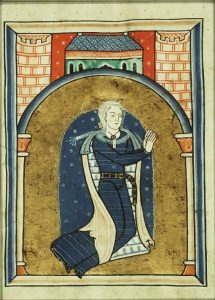
This session will examine the varied “visual signatures” of manuscript patrons, including dress, gestures, posture, and attributes of donor figures; heraldry and personalized inscriptions; marginal notes, colophons, dedications, and other signs of ownership and use in medieval manuscripts. Building on scholarship presented in the 2013 Index of Christian Art conference Patronage: Power and Agency in Medieval Art, this session will investigate the dynamic system of patronage centered on the interaction of owners with their books (whether as creator, patron, commissioner, or reader-viewer). Papers will address the importance of gender and social roles in book production, use, and readership, or will expand upon the role of patron as instigator in the book creation process, from payment to design.
“How Owner Portraits Work”
“The Patroness Portrait of the Fécamp Psalter (c. 1180): An Unknown Example of Royal Artistic Commission in Angevin Normandy”
“Patron Portrait as Creation Myth: On ‘Production Scenes’ in Illuminated Manuscripts”
In July 2016, Adelaide Bennett Hagens retired from the Index of Christian Art at Princeton University after fifty years of dedicated research and scholarship. She studied under Robert Branner at Columbia University and joined the Index during the directorship of Rosalie Green. Adelaide has studied medieval art in a variety of media, but her passion at the Index and in her personal research has always been manuscript illumination, particularly of the Gothic period. Her publications include “Some Perspectives on the Origins of Books of Hours in France in the Thirteenth Century,” in Books of Hours Reconsidered, edited by Sandra Hindman and James H. Marrow (2013); “Making Literate Lay Women Visible: Text and Image in French and Flemish Books of Hours, 1220–1320,” in Thresholds of Medieval Visual Culture: Liminal Spaces, edited by Elina Gertsman and Jill Stevenson (2012); and “The Windmill Psalter: The Historiated Letter E of Psalm One,” Journal of the Warburg and Courtauld Institutes 43 (1980). In two sessions, we celebrate Adelaide’s accomplishments and recognize her contributions to the Index of Christian Art and to the wider medieval and academic community.
It’s back to school time! Modern children enjoy the luxury of a school year that reflects an agrarian society, allowing time off during the summer months when all available hands were put to work in the fields. During the Middle Ages, many students lived, learned, and worked at home year round.
They learned how to be good citizens, and how to interact in society. They were taught basic Christian tenets and prayers. Boys learned a skill, following the family business, be it farming, blacksmithing, stone carving or brewing. Girls were taught how to run a household and the rudiments of the family business, to assist a future husband or possibly to take over business herself. In wealthier households, children learned similar life skills, but they had the advantage of becoming literate. A number of manuscripts exist that include the alphabet, Pater Noster, the credo, and familiar prayers as part of a book of hours. Under the guidance of parents, these books helped to form literate, religious offspring (Illus. 1).
Medieval art provides insights into the education of both boys and girls. Girls are shown at home, being individually tutored—as in the image of Agnes of Rome reading an open book before a seated tutor (Illus. 2)—or in small groups such as the one shown with the Virgin Mary and her mother (Illus. 3). Notably each of the girls has her own book, signaling a household of some wealth. Boys are shown at schools away from home. Jesus may be seen as a child carrying a paddle-shaped tablet with a panel of wax, slate, or parchment (Illus. 4). He is led by his mother, raising a scourge in her left hand—a view of the future, or merely an indicator of a boy who did not want to go to school? They walk toward an open-air building where the tutor holds an open book, showing the pages to several students. Other students study their own books, and several, including Jesus, wear what appear to be pen cases hanging from their belts. In another illustration, a single boy stands, perhaps reciting before the tutor, the rest of the class waiting their turns, some diligently studying open books, while one balances a book on his head (Illus. 5).
Not all were model students. Felix of Nola, whose story appears in the Golden Legend, is said to have been stabbed to death with styluses. The image here shows Felix lying on the floor of the school room, surrounded by students, one indeed holding a bloody stylus (Illus. 6). Aside from the goriness of the picture, it does give a sense of a school room. One basket, likely containing lunch, hangs on the wall while another is used as a weapon. A few books are visible, one open on a desk next to an inkpot and pen—likely a student’s blank book of either parchment or less expensive paper for recording lessons. One tablet is used as a weapon; another hangs on the wall. The same goes for satchels. A couple of students wear a pen case and ink pot on their belts; others hang on the wall.
Artists used marginal areas of a work of art to depict unusual ideas about a variety of topics, including education. A misbehaving monkey is whipped by his monkey tutor while two other monkeys look on, one with a sheet of paper or parchment on its lap (Illus. 7). A tutor holds withes in one hand and a tablet with the other while a grinning dog writes on the tablet, a stylus gripped in its right forepaw (Illus. 8). Above them are the letters ABC. Finally, a fox wearing a scholar’s cap, raising a baton with his right forepaw, teaches a flock of geese the art of singing. They all stand at a lectern with a book open perhaps to the text they are to sing (Illus. 9).
Illustrations:
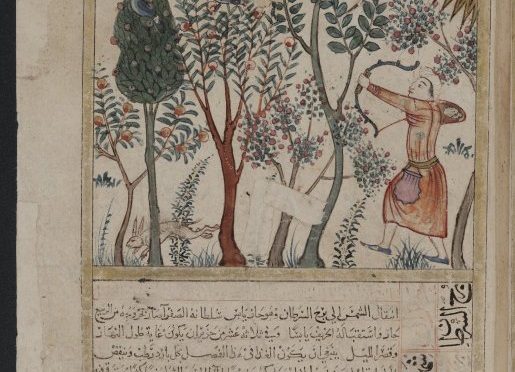
Observing the passing of time was central in medieval society, since climate had a profound effect on one’s livelihood and life habits. The turn of the seasons brought changes in diet, hygiene, mood, and activity, which were detailed and collected in a genre of late medieval health handbook known as Tacuinum Sanitatis (“The Maintenance of Health”). These show that, in preparing treatments, doctors took the time of the year, month and even day into account, along with six ‘non-natural’ factors—air, food and drink, motion and rest, sleep and waking, secretion and excretion, and mental state—as well as bathing (Jones 119; 133). Such factors are reflected in the Psalter of Lambert le Bèque, which includes twelve medallions forming a health calendar with rules and advice for each month and an image of a doctor with his assistants at the bottom of the page.
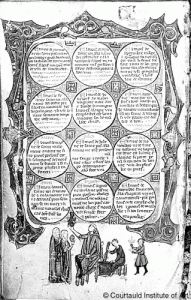
While elements of the illustrations were drawn from classical tradition, the medical recommendations and notion of time in the Tacuinum Sanitatis were heavily influenced by similar health handbooks in Arabic, the lingua franca of the Islamic world. The Tacuinum Sanitatis was based on an Arabic text written by Ibn Butlan, an eleventh-century Christian physician from Baghdad, who is credited as a source in manuscripts from Vienna, Paris, Casanatense, and Liège. His work was so respected by European translators that they even copied out mistakes made by previous Arabic copyists without change. Its translation into Latin in southern Italy or Sicily helped to disseminate it across Europe (Arano 8–11). The work’s Arabic origins are reflected in the title Tacuinum, which comes from the Arabic taqwim, meaning “table” and referring to the table-like organization of health handbooks in the Arabic tradition, a configuration possibly referenced in the square shape of the illustrations in the Tacuinum Sanitatis.

A sense of the Arabic source for the Tacuinum Sanitatis can be found in the Kitab al-Bulhān, a fifteenth-century miscellany in Arabic, now in the Bodleian Library in Oxford (MS. Bodl. Or. 133). The Bodleian manuscript compiled various astrological, astronomical, and divinatory texts. Notably, in its tale for the four seasons, it advised the following diet for the summer months:
“Food should be reduced and drink somewhat increased. Drinks must be well mixed with cold water and snow. Warm, dry medicines and foods must be avoided. Only delicate meat is to be eaten, such as that of black lamb (al-humldn al-suid). There is no harm in eating beef and goat’s meat if prepared with vinegar and celery (karafs). One should not linger in the bath nor should emetics be resorted to frequently.” (Arano color plate XII).
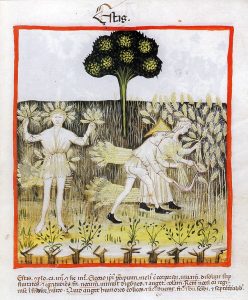
Similar instructions for a humid diet and delicate foods that can be easily digested also appear in a fourteenth-century Latin manuscript of the Tacuinum Sanitatis, written in Lombardy and held in the Österreichische Nationalbibliothek (Cod. Vindob. ser. nov. 2644, fol. 54r). This manuscript states that when nature is “warm in the third degree, dry in the second” the body is at its optimum health to beat “superfluities and cold diseases.”(Arano color plate XII). Yet the summer months were not without their health afflictions, like sluggish digestion or an increase in bilious humors. The Vienna Tacuinum codex suggests taking in a “humid diet” in a “cool environment” to overcome these disagreeable humors. The handbook states that a continuation of the diet works in “cold temperaments, for old people, and in Northern regions.” (Arano color plate XII).

The accompanying image of a youth wearing a crown of grain and holding a sprig is strikingly similar to depictions of the labors of the month and the personification of summer.
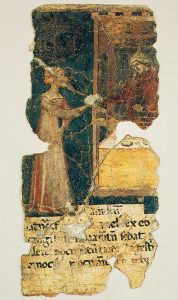
This imagery found its way into other media recorded by the Index, such as a Veronese fresco fragment in the Museo Civico di Castelvecchio in Verona. Dated to the last quarter of the fourteenth century, this fresco contains three scenes from the Tacuinum Sanitas. Fragments from the Palazzo dei Tribunali in Verona depict occupational scenes of cooking and commerce that address the inclusion of starch and dill in the diet.
Interestingly, once the Tacuinum text became popular in Europe, Italian innovations began making their way back into Arabic manuscripts. The illumination in the Lombardy manuscript was also influential in the development of contemporary landscape painting, focusing on the changes in nature itself, as well as human responses to them. This influence is perceptible in the Bodleian manuscript, made approximately a decade after the Italian manuscript. The illumination of seasons and cycles here shows a distinctly European approach with Arabic elements worked in. These details include turbaned figures in rich pastoral landscapes dotted with European architecture, a hunter’s long, pointed shoes, a half-length traditional gown, a belted pouch and a goblet of wine in the Autumn scene. And so the artist of the Bodleian Kitab al-Bulhān blended elements of both cultures with innovations of his own, according to his taste.
The Index catalogs many images of seasonal and medical imagery, including “Scene, Occupational: Doctoring” (60+ work of art records) and “Scene, Occupational: Cooking” (70+ work of art records).
Sources:
Ann Henisch, Bridget. The Medieval Calendar Year. (University Park, PA: Penn State University Press, 1999)
Carson Webster, James.The Labors of the Months in Antique and Medieval Art to the End of the Twelfth Century. (Princeton: Princeton University Press, 1938)
Cogliati Arano, Luisa. Medieval Health Handbook: Tacuinum Sanitatis. (New York: George Brazilier, 1976)
Hourihane, Colum, ed. Time in the Medieval World: Occupations of the Months and Signs of the Zodiac in the Index of Christian Art. (Pennsylvania: Penn State University Press, 2007)
Murray Jones, Peter. Medieval Medical Manuscripts. (Austin: University of Texas Press, 1984)
Rice, D. S. ‘The Seasons and the Labors of the Months in Islamic Art’. Ars Orientalis 1 (1954): 1-39. http://www.jstor.org/stable/pdf/4628981.pdf
This guest blog post was written by Rachel Dutaud, a summer student assistant at the Index of Christian Art and a fourth year art history student at the University of St. Andrews. Rachel is completing her undergraduate dissertation on the portraiture of Hatshepsut, Olympias of Macedonia, and Theodora. Her interests are in Early Christian and Byzantine art, classicism, iconography, and archives.